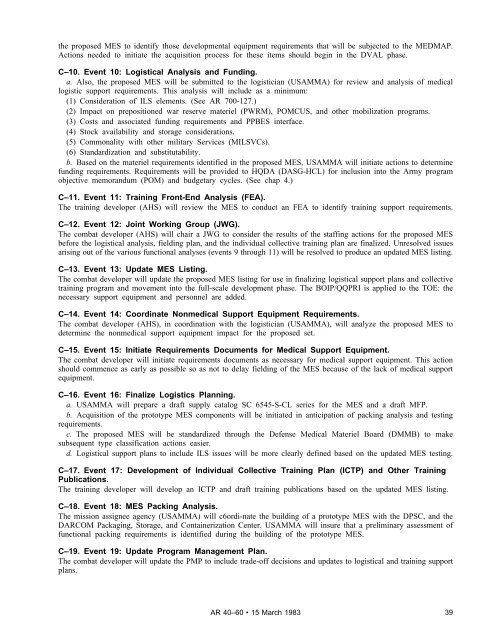policies and procedures for the acquisition of medical materiel
policies and procedures for the acquisition of medical materiel
policies and procedures for the acquisition of medical materiel
Create successful ePaper yourself
Turn your PDF publications into a flip-book with our unique Google optimized e-Paper software.
<strong>the</strong> proposed MES to identify those developmental equipment requirements that will be subjected to <strong>the</strong> MEDMAP.Actions needed to initiate <strong>the</strong> <strong>acquisition</strong> process <strong>for</strong> <strong>the</strong>se items should begin in <strong>the</strong> DVAL phase.C–10. Event 10: Logistical Analysis <strong>and</strong> Funding.a. Also, <strong>the</strong> proposed MES will be submitted to <strong>the</strong> logistician (USAMMA) <strong>for</strong> review <strong>and</strong> analysis <strong>of</strong> <strong>medical</strong>logistic support requirements. This analysis will include as a minimum:(1) Consideration <strong>of</strong> ILS elements. (See AR 700-127.)(2) Impact on prepositioned war reserve <strong>materiel</strong> (PWRM), POMCUS, <strong>and</strong> o<strong>the</strong>r mobilization programs.(3) Costs <strong>and</strong> associated funding requirements <strong>and</strong> PPBES interface.(4) Stock availability <strong>and</strong> storage considerations.(5) Commonality with o<strong>the</strong>r military Services (MILSVCs).(6) St<strong>and</strong>ardization <strong>and</strong> substitutability.b. Based on <strong>the</strong> <strong>materiel</strong> requirements identified in <strong>the</strong> proposed MES, USAMMA will initiate actions to determinefunding requirements. Requirements will be provided to HQDA (DASG-HCL) <strong>for</strong> inclusion into <strong>the</strong> Army programobjective memor<strong>and</strong>um (POM) <strong>and</strong> budgetary cycles. (See chap 4.)C–11. Event 11: Training Front-End Analysis (FEA).The training developer (AHS) will review <strong>the</strong> MES to conduct an FEA to identify training support requirements.C–12. Event 12: Joint Working Group (JWG).The combat developer (AHS) will chair a JWG to consider <strong>the</strong> results <strong>of</strong> <strong>the</strong> staffing actions <strong>for</strong> <strong>the</strong> proposed MESbe<strong>for</strong>e <strong>the</strong> logistical analysis, fielding plan, <strong>and</strong> <strong>the</strong> individual collective training plan are finalized. Unresolved issuesarising out <strong>of</strong> <strong>the</strong> various functional analyses (events 9 through 11) will be resolved to produce an updated MES listing.C–13. Event 13: Update MES Listing.The combat developer will update <strong>the</strong> proposed MES listing <strong>for</strong> use in finalizing logistical support plans <strong>and</strong> collectivetraining program <strong>and</strong> movement into <strong>the</strong> full-scale development phase. The BOIP/QQPRI is applied to <strong>the</strong> TOE: <strong>the</strong>necessary support equipment <strong>and</strong> personnel are added.C–14. Event 14: Coordinate Non<strong>medical</strong> Support Equipment Requirements.The combat developer (AHS), in coordination with <strong>the</strong> logistician (USAMMA), will analyze <strong>the</strong> proposed MES todetermine <strong>the</strong> non<strong>medical</strong> support equipment impact <strong>for</strong> <strong>the</strong> proposed set.C–15. Event 15: Initiate Requirements Documents <strong>for</strong> Medical Support Equipment.The combat developer will initiate requirements documents as necessary <strong>for</strong> <strong>medical</strong> support equipment. This actionshould commence as early as possible so as not to delay fielding <strong>of</strong> <strong>the</strong> MES because <strong>of</strong> <strong>the</strong> lack <strong>of</strong> <strong>medical</strong> supportequipment.C–16. Event 16: Finalize Logistics Planning.a. USAMMA will prepare a draft supply catalog SC 6545-S-CL series <strong>for</strong> <strong>the</strong> MES <strong>and</strong> a draft MFP.b. Acquisition <strong>of</strong> <strong>the</strong> prototype MES components will be initiated in anticipation <strong>of</strong> packing analysis <strong>and</strong> testingrequirements.c. The proposed MES will be st<strong>and</strong>ardized through <strong>the</strong> Defense Medical Materiel Board (DMMB) to makesubsequent type classification actions easier.d. Logistical support plans to include ILS issues will be more clearly defined based on <strong>the</strong> updated MES testing.C–17. Event 17: Development <strong>of</strong> Individual Collective Training Plan (ICTP) <strong>and</strong> O<strong>the</strong>r TrainingPublications.The training developer will develop an ICTP <strong>and</strong> draft training publications based on <strong>the</strong> updated MES listing.C–18. Event 18: MES Packing Analysis.The mission assignee agency (USAMMA) will c6ordi-nate <strong>the</strong> building <strong>of</strong> a prototype MES with <strong>the</strong> DPSC, <strong>and</strong> <strong>the</strong>DARCOM Packaging, Storage, <strong>and</strong> Containerization Center. USAMMA will insure that a preliminary assessment <strong>of</strong>functional packing requirements is identified during <strong>the</strong> building <strong>of</strong> <strong>the</strong> prototype MES.C–19. Event 19: Update Program Management Plan.The combat developer will update <strong>the</strong> PMP to include trade-<strong>of</strong>f decisions <strong>and</strong> updates to logistical <strong>and</strong> training supportplans.AR 40–60 • 15 March 198339
















